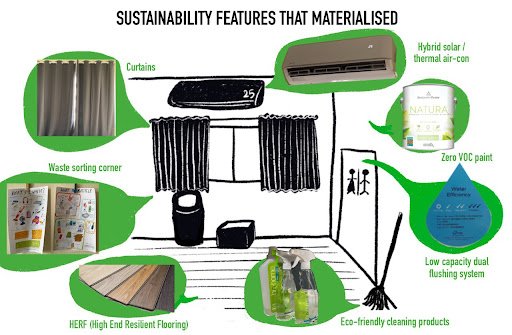Moving places, Moving people: Sustainability as a collective practice
By Yeo Rui Qi
Rui Qi, a Gap Year Intern at Skillseed, shares her reflections on being the resident “sustainability officer” in planning Skillseed’s recent office move.
It hadn’t been long since I had joined Skillseed when I was asked to support in the planning of Skillseed’s move to our new office. At first, I wasn’t sure how helpful I would be - having entered Skillseed in the middle of the COVID-19 pandemic, I had been working from home since Day 1 and had little inkling of what the team’s vision of an office would be, nor did I have any experience in moving houses or offices.
Eventually, I saw my role in the Office Move team as the resident “sustainability officer”, having had some prior experience in several sustainability projects focused on reducing environmental impact. But while the previous projects I had been involved in often required quite a bit of coaxing of stakeholders, I was pleasantly surprised that I did not have to do much (if at all) to convince the team at Skillseed to make environmentally-conscious decisions. In fact, it was Wilson, our Director, who envisioned a low-impact and healthy workspace and requested my support in realising that vision.
When I realised that environmental impact was an important consideration for decision-making at Skillseed, I entertained big ideas for the office in my head -- a well-ventilated space that can be cooled with fans rather than air-conditioning; VOC-free flooring and walls; edible plants and a vermi-composting system; window films to keep out the heat while making full use of daylight; pre-loved (or second-hand) furniture; and even a greywater reuse system and eco-toilet bowl. These dreams were dampened, however, by the realities of a social enterprise – we had limited funds, time, and manpower, and we had to maximise our efforts with our limited resources.
As with most small enterprises, we needed to be prudent with our financial resources. We were lucky to source some green features that were priced inexpensively, like the “Zero-VOC” paints from Benjamin Moore, and relational providers who are keen to help social enterprises, like Ecoline which produces hybrid air-conditioners that harness solar and ambient heat energy. However, some of our dreams were further from reality - tinted windows and dimmable lights were too expensive, so we made do with curtains. Pre-loved furniture might sometimes be more affordable, but when delivery was considered, the amount often added up to a lot more since we would have to engage an external delivery service – so we chose to reuse as much of our old furniture and buy only what we needed. A greywater reuse system would be a big project that we would not have the time to build and maintain, so we settled with low-water flushes.
Yet, it wasn’t a straightforward quantitative weighing between financial cost and environmental benefit. We made numerous tables to weigh the pros and cons of the sustainability features. Beyond the one-off financial costs, we considered the environmental impact over the life cycle of the product and the long term savings we might make. Did the so-called “Eco Toilet Bowl”, which had a tap and basin over its water tank to reuse hand-washing water as flush water, actually reduce water use? We found out that it would incur additional water use for washing the extra basin, while its flushing system also used larger volumes of water compared to dual flushing systems in more conventional style toilets. As for flooring, between HERF (High-End Resilient Flooring) and bamboo, which would be a better “sustainable” alternative? We discovered that while HERF is more durable and did not require adhesives (which might release formaldehyde, a gas that is carcinogenic at high levels and can cause irritation in the skin, eyes, nose and throat), it is composed of a synthetic material made of crude oil through an energy-intensive process. Bamboo flooring, on the other hand, while a fast-growing renewable resource that sequesters carbon, is less durable and might require adhesives. At the same time, it was unclear whether the bamboo are sustainably and ethically sourced as many suppliers were not transparent about their sources, so there was no way to know if the bamboo might have been cultivated in monocultures and/or on land deforested specifically for its cultivation. All these considerations made for a complicated decision-making process – there was no black-or-white “correct” answer, and we often had to spend time deliberating the pros and cons as a team before deciding which option we were most comfortable with.
Cecilia, a fellow Skillseedee who worked alongside me in the Office Move team, echoed similar sentiments when I asked her about her own sustainability habits in her daily life. She shared with me that working in Skillseed and witnessing how environmental considerations influence our decision-making process has inspired her to live a more sustainable lifestyle. Still, she was often confused and uncertain about which products would be the “best” choice for the environment, raising the example of the different types of plastic packagings that different brands use, from “hard plastics” (often used for detergent and bleach bottles) to “soft plastics” (plastic bags, squeezable bottles) which have different levels of reusability and recyclability, as well as resource intensity. “I don’t know either,” was my honest answer to her when she tried to probe me for tips. “There’s too much to consider and too little information available to consumers.”
Given the difficulties faced in making sustainable choices, Cecilia shared that while she finds it important to maintain these sustainable practices, she sometimes wonders if it is worth the trouble and if it makes a difference given that she is just one individual trying to make changes in one household. Indeed, while this reasoning is often used by climate deniers to decline action, it is also one that is privately shared amongst many sustainability advocates. After all, it is exhausting to live in a world where environmental harm has become a system default, such that environmental good - or even neutrality - requires additional effort to push back as individuals. But I think this is why I find it even more meaningful when organisations like Skillseed choose to make decisions with the environment in consideration. As individuals, there is so much frustration and confusion. But as an organisation, there can be collective learning and encouragement, and a sense of surety that what we are doing is larger than ourselves.
As Skillseed rounds up our moving process, we are also building up what we fondly call our “Regenerative Corner” – a “fancy name” for an area in the office with plants, a composting system, and a waste sorting system. I’m personally more excited for this space in the office than my own tiny collection of plants at home, because I know that while my version at home is a lone project, the one in our office will be tended to by a team of enthusiastic, or at least curious, learners. In the process of moving places, I’m grateful that we have created the space in Skillseed for it to also become a process of moving people to act. As a team, the fears that we individually have such as “I don’t have green fingers, what if I kill the plants?” evolve into a willingness to try – “I don’t have green fingers, but I will try my best” was what a fellow Skillseedee remarked when we shared the plans for the Regenerative Corner with the team. In my mind, her remark encapsulates how workplace practices and culture can play such a powerful role in effecting change – not only through influencing individual employees to adopt similar habits in their daily life as seen in Cecilia’s case, but also by providing the necessary infrastructure and institutional support to reframe seemingly daunting tasks into more approachable steps. Rather than seeing sustainability merely as individual habits that we can adopt, therefore, wouldn’t it be much more powerful if we can move each other to act by creating spaces for collective learning and institutional change?
References
About Greywater Reuse. (n.d.). Greywater Action. Retrieved 31 January 2022, from https://greywateraction.org/greywater-reuse/
Bahadori-Jahromi, A., Rotimi, A., Mylona, A., Godfrey, P., & Cook, D. (2017). Impact of Window Films on the Overall Energy Consumption of Existing UK Hotel Buildings. Sustainability, 9(731). https://doi.org/10.3390/su9050731
Benjamin Moore Paints Singapore. (n.d.). Retrieved 31 January 2022, from https://www.benjaminmoore.sg/
Carr, R. (2016, January 6). Vermicomposting for Beginners—Rodale Institute. Rodale Institute. https://rodaleinstitute.org/science/articles/vermicomposting-for-beginners/
Chin, K. T. (2019, July 1). HDB’s eco toilet option runs counter to water-saving efforts. TODAYonline. https://www.todayonline.com/voices/hdbs-eco-toilet-option-runs-counter-water-saving-efforts
Ecoline Solar. (2022). https://ecolinesolar.com.sg/
Evo High End Resilient Flooring. (n.d.). EVORICH. Retrieved 31 January 2022, from https://evorich.com.sg/products/indoor-flooring/evo-herf/
Lewitin, J. (2021, May 16). Advantages and Disadvantages of Bamboo Flooring. The Spruce. https://www.thespruce.com/benefits-and-drawbacks-of-bamboo-floors-1314694
Resins and Types of Packaging. (n.d.). Advancing Circular Packaging. Retrieved 31 January 2022, from https://www.advancingcircularpackaging.com/sustainable-plastic-packaging/resins-and-types-of-packaging/
US EPA. (2022, January 4). What are volatile organic compounds (VOCs)? [Overviews and Factsheets]. United States Environmental Protection Agency - Indoor Air Quality (IAQ). https://www.epa.gov/indoor-air-quality-iaq/what-are-volatile-organic-compounds-vocs
Image sources:
https://aghardware.sg/product/cosmos-two-piece-water-closet-eco-friendly-1004e/
https://www.laminate-flooring.com.sg/news/herf-flooring-completely-100-waterproof.html
https://inhabitat.com/the-sloan-aqus-greywater-recycling-system/sloanaqus-ed03/
https://www.laminate-flooring.com.sg/news/herf-flooring-completely-100-waterproof.html


